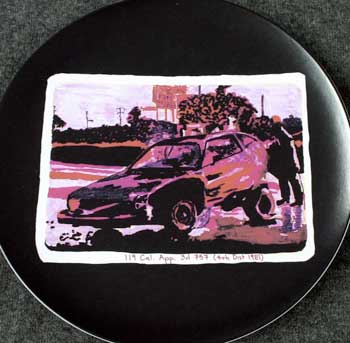Warren Burger and Fries
Harvard Law School students, in their second or third year working on a J.D., must complete the school’s Written Work Requirement: a writing project, beyond what’s required in their regular classes, supervised and approved by a member of the faculty. Jose Klein ’97, graduating from Harvard Law this spring, satisfied this requirement in a somewhat unusual manner: a series of plastic plates made from his drawings of Supreme Court justices and images representing legendary court cases—a project Klein, punning on the name of a famous judge, calls his “Learned Handmade Plates.”
Plastic plates made from drawings? The logistics of this will be familiar to many readers, either from their experiences as parents or possibly from their own childhoods: Klein buys the Make-A-Plate kit, made by a company called Makit Products, which comes with five special heat-treated and die-cut circular drawing sheets and a set of water-soluble pens; he mails the drawings back to Makit; they send him one ten-inch Melamine plate per drawing (with the option of purchasing multiple duplicates in the future).
The target audience for Make-A-Plate kits is, of course, children. And Klein and his wife, Rosa, who also graduated from Harvard this year (a master’s in Public Policy from the Kennedy School of Government), have a son, Manu, age three. But Manu isn’t the reason why the plate project started. “My wife used to make these plates as a kid,” Klein says, “and we decided to bring a set to a family reunion we had a couple of summers ago, and I quickly became obsessed with it.” He says that his whole life, even growing up, he never drew at all. But one morning last summer he told Rosa, a former college art major, that he “was going to teach [himself] how to draw.” The Make-A-Plate kits were how he began. “There was something about the unpretentiousness of the medium and the usefulness of the end product that drew me towards making the plates,” he says. His wife gave him “some pointers,” and he’s “been working on it ever since.”
Klein stumbled on the combination of his new art form with his legal education this past winter. Author and attorney Jeffrey Toobin came to speak at Harvard Law, his alma mater; after his talk, Klein says, Toobin gave away free copies of his 2007 book The Nine: Inside the Secret World of the Supreme Court. Klein was looking at a picture in the book of Justice Scalia’s famous hand gesture from 2006 and he “resolved to try to draw it.”
After finishing the Scalia drawing, though, “I had to do the other eight [Supreme Court justices],” he says—“and away I went with the whole project.”

Klein’s project then grew to include drawings of images representing famous legal cases, which began, he thinks, with Grimshaw v. Ford (pictured on opposite page). “Torts had been my favorite class,” he says, “and for some reason I thought it would be fun to draw the infamous exploding Ford Pinto.” The cases he’s chosen to make plates for are “an album of the law school curriculum,” he says. “Most law students have been expected to memorize most of [these] cases.” In other words, the plates might serve as a kind of a set of legal flash cards, albeit ones off of which a law student might eat dinner.
Klein was an English major at Vassar with an emphasis on creative writing; his original idea, for his third year at Harvard, was to satisfy the Written Work Requirement creatively with “a collection of short stories related to legal themes.” The trouble with that plan, however, was that he hadn’t been writing. “In my free time I was much more interested in drawing,” he says. He showed his advisor, Professor Richard Parker, what he’d been working on, and Parker ultimately gave the project his approval.
What has the reaction from his fellow students been like? “Very positive,” Klein says, although he suspects that some “are a bit mystified that someone can get academic credit for something so removed from the traditional study of law.” (“Why were we dumb enough to do a 40-page paper?” asked an article about the plates in Harvard Law School’s student-run newspaper The Record.)
Klein says he got “a wonderful education” at Vassar. “What I am most grateful for,” he says, is the way in which the school “encouraged individuality. At every turn, I was rewarded for thinking for myself, for being myself.” After Vassar, he struggled with trying to succeed as a fiction writer, feeling paralyzed, at times, by the work of writing. But joining the Peace Corps, he says—he worked in Suriname, South America, from 2002–04—not only liberated him from his struggle with writing, but changed his career goals as well. “It broadened my sense of what the world is like, how people live, and what constitutes the good life. My Peace Corps experiences deepened my commitment to social justice—which was central to my decision to go to law school.”
Klein and his family are moving to Portland, Oregon, where he will begin a clerkship with the Honorable Martha L. Walters of the Oregon Supreme Court. He’ll keep making plates, and even hopes to use them “as a springboard for fundraising for causes related to social justice.” This fall, he says, the Oregon Affiliate of the American Civil Liberties Union is going to use the plates for a fundraising dinner. Klein is presently at work “on a series of plates devoted to people who have been exonerated through DNA evidence,” he says. “It’s my hope that these plates can be used to generate money either to support post-conviction relief of individuals or to compensate people wrongfully incarcerated.
“But moving forward on this,” he adds,“will have to wait until after I finish finals.”
